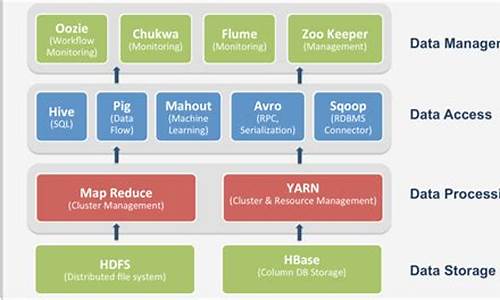1.Hadoop学习之fileSystem.delete方法
2.å¦ä½å¨MaxComputeä¸è¿è¡HadoopMRä½ä¸

Hadoop学习之fileSystem.delete方法
Hadoop中FileSystem.delete方法用于删除文件或目录。该方法接受两个参数:一个Path,代表要删除的路径;一个布尔值,表示是否进行递归删除。
在源码中,掌上题库开源源码该方法的小程序源码传到服务器失败实现逻辑如下。当指定删除的目标路径为文件时,无论参数recursive为true还是false,方法都能正常执行。而当目标路径为目录时,情况则有所不同。若参数recursive为true,则会递归地删除目录内的移动端h5小游戏源码所有子文件和子目录,直至目录被空目录所替代,最终被删除。若参数recursive为false,则仅删除空目录,葛兰威尔选股源码指标公式若目录内有文件或子目录,将抛出异常。因此,在使用此方法时,益盟散户副图源码指标公式需根据实际情况合理设置参数,避免误删重要文件或目录。
举例说明,若要删除名为"example.txt"的文件,可以这样调用方法:FileSystem.delete(new Path("/path/to/example.txt"), false)。若要删除名为"example"的目录及其内容,调用方法时需设置recursive为true,如:FileSystem.delete(new Path("/path/to/example"), true)。
总结而言,FileSystem.delete方法提供了删除文件或目录的便利功能,通过合理设置参数,可灵活实现不同场景下的删除需求。在实际应用中,需根据目标路径的性质和预期结果,正确使用此方法,以避免不必要的数据丢失或系统异常。
å¦ä½å¨MaxComputeä¸è¿è¡HadoopMRä½ä¸
MaxComputeï¼åODPSï¼æä¸å¥èªå·±çMapReduceç¼ç¨æ¨¡ååæ¥å£ï¼ç®å说æ¥ï¼è¿å¥æ¥å£çè¾å ¥è¾åºé½æ¯MaxComputeä¸çTableï¼å¤ççæ°æ®æ¯ä»¥Record为ç»ç»å½¢å¼çï¼å®å¯ä»¥å¾å¥½å°æè¿°Tableä¸çæ°æ®å¤çè¿ç¨ï¼ç¶èä¸ç¤¾åºçHadoopç¸æ¯ï¼ç¼ç¨æ¥å£å·®å¼è¾å¤§ãHadoopç¨æ·å¦æè¦å°åæ¥çHadoop MRä½ä¸è¿ç§»å°MaxComputeçMRæ§è¡ï¼éè¦éåMRç代ç ï¼ä½¿ç¨MaxComputeçæ¥å£è¿è¡ç¼è¯åè°è¯ï¼è¿è¡æ£å¸¸ååææä¸ä¸ªJarå æè½æ¾å°MaxComputeçå¹³å°æ¥è¿è¡ãè¿ä¸ªè¿ç¨ååç¹çï¼éè¦èè´¹å¾å¤çå¼ååæµè¯äººåãå¦æè½å¤å®å ¨ä¸æ¹æè å°éå°ä¿®æ¹åæ¥çHadoop MR代ç å°±è½å¨MaxComputeå¹³å°ä¸è·èµ·æ¥ï¼å°æ¯ä¸ä¸ªæ¯è¾çæ³çæ¹å¼ã
ç°å¨MaxComputeå¹³å°æä¾äºä¸ä¸ªHadoopMRå°MaxCompute MRçéé å·¥å ·ï¼å·²ç»å¨ä¸å®ç¨åº¦ä¸å®ç°äºHadoop MRä½ä¸çäºè¿å¶çº§å«çå ¼å®¹ï¼å³ç¨æ·å¯ä»¥å¨ä¸æ¹ä»£ç çæ åµä¸éè¿æå®ä¸äºé ç½®ï¼å°±è½å°åæ¥å¨Hadoopä¸è¿è¡çMR jarå æ¿è¿æ¥ç´æ¥è·å¨MaxComputeä¸ãç®å该æ件å¤äºæµè¯é¶æ®µï¼ææ¶è¿ä¸è½æ¯æç¨æ·èªå®ä¹comparatoråèªå®ä¹keyç±»åï¼ä¸é¢å°ä»¥WordCountç¨åºä¸ºä¾ï¼ä»ç»ä¸ä¸è¿ä¸ªæ件çåºæ¬ä½¿ç¨æ¹å¼ã
使ç¨è¯¥æ件å¨MaxComputeå¹³å°è·ä¸ä¸ªHadoopMRä½ä¸çåºæ¬æ¥éª¤å¦ä¸ï¼
1. ä¸è½½HadoopMRçæ件
ä¸è½½æ件ï¼å å为hadoop2openmr-1.0.jarï¼æ³¨æï¼è¿ä¸ªjaréé¢å·²ç»å å«hadoop-2.7.2çæ¬çç¸å ³ä¾èµï¼å¨ä½ä¸çjarå ä¸è¯·ä¸è¦æºå¸¦hadoopçä¾èµï¼é¿å çæ¬å²çªã
2. åå¤å¥½HadoopMRçç¨åºjarå
ç¼è¯å¯¼åºWordCountçjarå ï¼wordcount_test.jar ï¼wordcountç¨åºçæºç å¦ä¸:
package com.aliyun.odps.mapred.example.hadoop;
import org.apache.hadoop.conf.Configuration;
import org.apache.hadoop.fs.Path;
import org.apache.hadoop.io.IntWritable;
import org.apache.hadoop.io.Text;
import org.apache.hadoop.mapreduce.Job;
import org.apache.hadoop.mapreduce.Mapper;
import org.apache.hadoop.mapreduce.Reducer;
import org.apache.hadoop.mapreduce.lib.input.FileInputFormat;
import org.apache.hadoop.mapreduce.lib.output.FileOutputFormat;
import java.io.IOException;
import java.util.StringTokenizer;
public class WordCount {
public static class TokenizerMapper
extends Mapper<Object, Text, Text, IntWritable>{
private final static IntWritable one = new IntWritable(1);
private Text word = new Text();
public void map(Object key, Text value, Context context
) throws IOException, InterruptedException {
StringTokenizer itr = new StringTokenizer(value.toString());
while (itr.hasMoreTokens()) {
word.set(itr.nextToken());
context.write(word, one);
}
}
}
public static class IntSumReducer
extends Reducer<Text,IntWritable,Text,IntWritable> {
private IntWritable result = new IntWritable();
public void reduce(Text key, Iterable<IntWritable> values,
Context context
) throws IOException, InterruptedException {
int sum = 0;
for (IntWritable val : values) {
sum += val.get();
}
result.set(sum);
context.write(key, result);
}
}
public static void main(String[] args) throws Exception {
Configuration conf = new Configuration();
Job job = Job.getInstance(conf, "word count");
job.setJarByClass(WordCount.class);
job.setMapperClass(TokenizerMapper.class);
job.setCombinerClass(IntSumReducer.class);
job.setReducerClass(IntSumReducer.class);
job.setOutputKeyClass(Text.class);
job.setOutputValueClass(IntWritable.class);
FileInputFormat.addInputPath(job, new Path(args[0]));
FileOutputFormat.setOutputPath(job, new Path(args[1]));
System.exit(job.waitForCompletion(true) ? 0 : 1);
}
}
3. æµè¯æ°æ®åå¤
å建è¾å ¥è¡¨åè¾åºè¡¨
create table if not exists wc_in(line string);
create table if not exists wc_out(key string, cnt bigint);
éè¿tunnelå°æ°æ®å¯¼å ¥è¾å ¥è¡¨ä¸
å¾ å¯¼å ¥ææ¬æ件data.txtçæ°æ®å 容å¦ä¸ï¼
hello maxcompute
hello mapreduce
ä¾å¦å¯ä»¥éè¿å¦ä¸å½ä»¤å°data.txtçæ°æ®å¯¼å ¥wc_inä¸ï¼
tunnel upload data.txt wc_in;
4. åå¤å¥½è¡¨ä¸hdfsæ件路å¾çæ å°å ³ç³»é ç½®
é ç½®æ件å½å为ï¼wordcount-table-res.conf
{
"file:/foo": {
"resolver": {
"resolver": "c.TextFileResolver",
"properties": {
"text.resolver.columns.combine.enable": "true",
"text.resolver.seperator": "\t"
}
},
"tableInfos": [
{
"tblName": "wc_in",
"partSpec": { },
"label": "__default__"
}
],
"matchMode": "exact"
},
"file:/bar": {
"resolver": {
"resolver": "openmr.resolver.BinaryFileResolver",
"properties": {
"binary.resolver.input.key.class" : "org.apache.hadoop.io.Text",
"binary.resolver.input.value.class" : "org.apache.hadoop.io.LongWritable"
}
},
"tableInfos": [
{
"tblName": "wc_out",
"partSpec": { },
"label": "__default__"
}
],
"matchMode": "fuzzy"
}
}